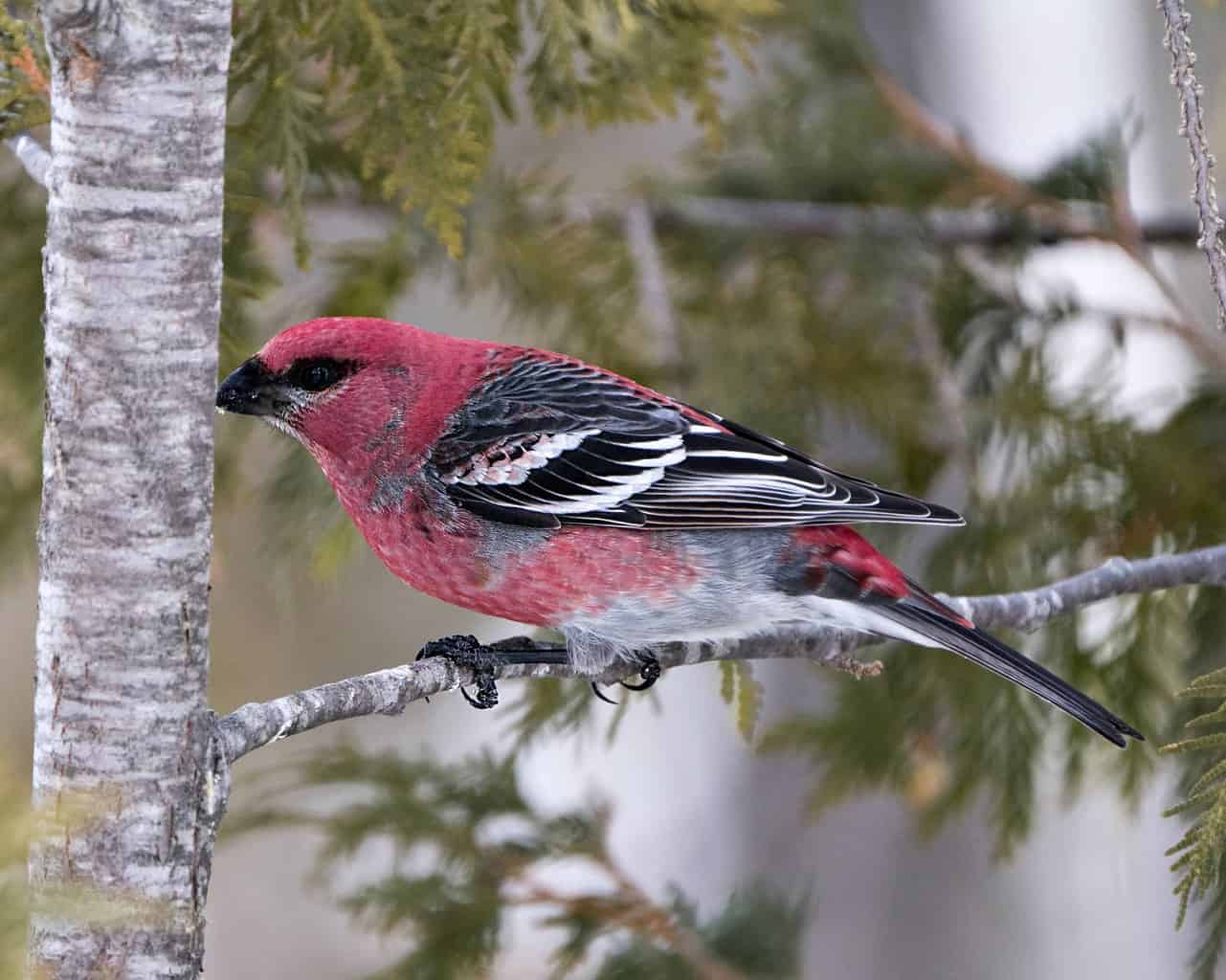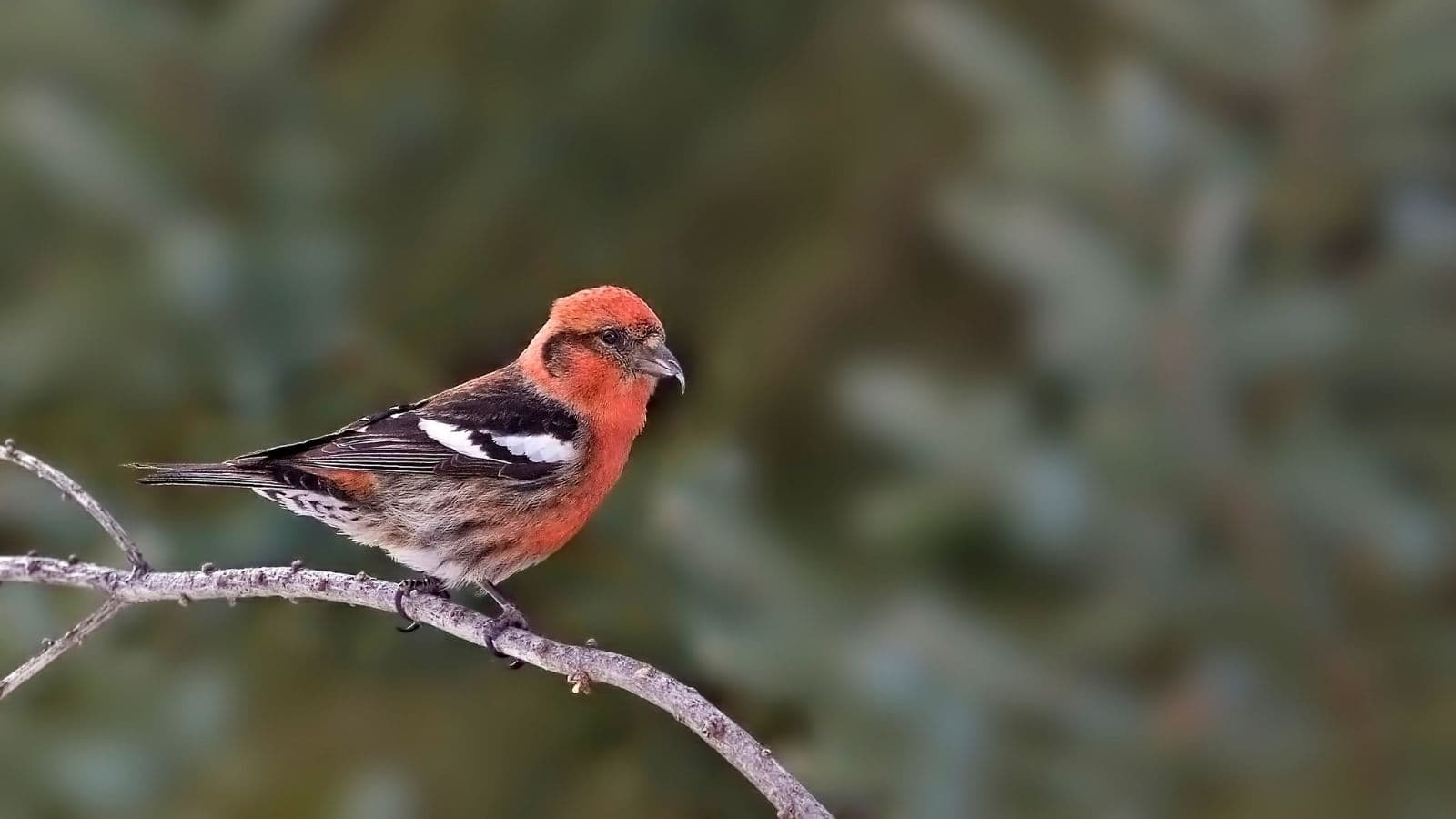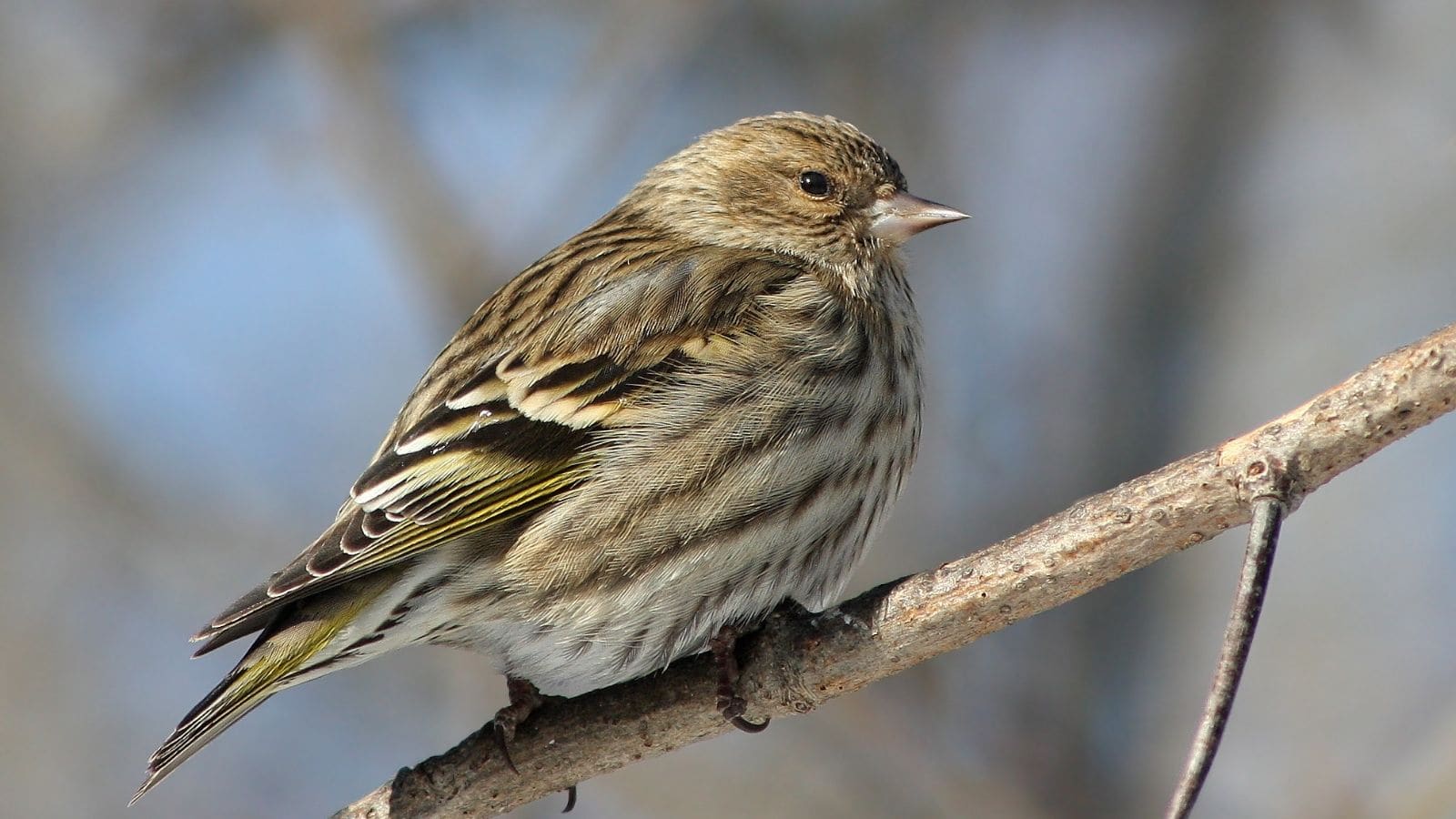Its state birds are the northern mockingbird known for its gift of mimicry and fondness for mild weather, and the bobwhite quail, a sought-after game bird.
Certain species such as blue jays, cardinals, and song sparrows can be seen all year long in this state bordered by the Mississippi to its west and the Blue Ridge Mountains to its east. Others, however, such as rose-breasted grosbeaks, scarlet tanagers, and yellow-throated vireos, pass through with the intent of reaching climes that are more to their preference.
There are 423 bird species in Tennessee, ten of which are finches. Here you’ll find all you need to know about them including their key features and their migratory patterns within this state which is Kentucky’s southern neighbor.
Evening Grosbeak

- Scientific Name: Hesperiphona vespertina
- Length: 6 – 9 inches
- Weight: 1.3 – 3.0 ounces
- Wingspan: 12 – 14 inches
In terms of size, the evening grosbeak is one of the larger finch species. Male birds can be recognized by a bold, pale green beak with the upper slightly longer than the lower.
Thick yellow strokes sit above both dark eyes converging between them, making them even harder to miss.
Their upper and undersurfaces are a yellow brown forming a striking contrast against wings which are white at their centers and black everywhere else.
Females share the same pattern on their wings as the males. However, their plumage comes in a more modest pale gray ringed with yellow at the neck.
Evening grosbeaks can be found in Tennessee although they are not regular visitors to the state. They are more commonly found in Southern Canada, Washington, northern Oregon, and Idaho, and western Montana and Wyoming.
Pine Grosbeak

- Scientific Name: Pinicola enucleator
- Length: 8 – 10 inches
- Weight: 2 – 3 ounces
- Wingspan: 13 inches
Male pine grosbeaks are clad in plumage which is somewhat dark red while their female counterparts, on the other hand, are gray.
Both genders share a rather sturdy build, and dark wing and tail feathers (their wing feathers are edged with white). The species, which is surprisingly tolerant of human curiosity, can be found for the most part in Canada. However, it can also be found further to the south in the western and southwestern United States.
Like evening grosbeaks, pine grosbeaks are rarely found in Tennessee. This is because their eastern range ends at Pennsylvania.
Purple Finch

- Scientific Name: Haemorhous purpureus
- Length: 4.7 – 6.3 inches
- Weight: 0.63 – 1.10 ounces
- Wingspan: 10 inches
Considered to be more docile compared to the highly adaptive house finch, purple finches also bear a close resemblance to these close relatives which have spread eastwards in a spectacular display of adaptability.
However, purple finches possess heads that are somewhat larger and rounder and completely pink in males but brown in females. The rest of the plumage is brown and covered in bold streaks against a pale background. In males, it is also suffused with pink.
These passerines visit Tennessee in winter and can be found all over the state.
Although the species breeds in Canada, its range also extends to North America’s Pacific Coast to Mexico. Its eastern range begins from eastern South Dakota to eastern Texas and extends to the Atlantic Coast.
House Finch

- Scientific Name: Haemorhous mexicanus
- Length: 6 inches
- Weight: 0.6 – 0.9 ounces
- Wingspan: 10 inches
Originally found in the western United States, the house finch has since spread eastwards in a truly impressive display of survivability.
In spite of its resemblance to the purple finch, this species can be distinguished by its head and body which have narrower profiles compared to those of its more docile relative.
There is also the issue of coloring as well: male purple finches are covered in a shade of red with a hint of orange making it somewhat sharper than the soft pinkish hue of purple finches.
The streaking on female house finches is also less pronounced compared to female purple finches.
This species can be found throughout the United States and can also be found all over Tennessee throughout the year.
Common Redpoll

- Scientific Name: Acanthis flammea
- Length: 4.5 – 5.5 inches
- Weight: 0.4 – 0.6 ounces
- Wingspan: 8 – 9 inches
Common redpolls can be recognized by a blood-red patch on their foreheads and plumage which is mostly pale gray-white streaked through with brown. Their wing feathers are also predominantly brown although they turn pale at their tips and edges. Males also come with a flush of pink at the chest.
This species is known for preferring to live in boreal forests and can be found in Canada, only moving southwards owing to the absence of their favorite foods during winter. Although they are rare winter visitors to the central United States, they may be spotted in northern Tennessee which forms part of the southernmost extremity of their range.
Red Crossbill

- Scientific Name: Loxia curvirostra
- Length: 7.9 inches
- Weight: 2 ounces
- Wingspan: 12 inches
Like other related species red crossbills take their name from their characteristic crisscrossed gray bills. These specialized beaks have evolved to enable them to get right to the nutritious contents of conifer cones with ease.
Males of the species are covered in a coppery red hue as opposed to their female counterparts which are gray-brown with touches of pale bronze at the chest and upper surface.
Red crossbills’ range lies in North America’s west and southwest. However, they can also be found in Tennessee’s northeastern tip which forms part of a smaller range in the eastern part of the United States.
White-Winged crossbill

- Scientific Name: Loxia leucoptera
- Length: 5.7 – 6.7 inches
- Weight: 0.9 – 1.40 ounces
- Wingspan: 11 inches
In spite of their name, the wings of this species are black edged with white, a pattern also present at their tails.
Male white-winged crossbills are covered in red plumage while females on the other hand have plumage that is grayish-brown with touches of bronze at the face, head, and chest.
In keeping with their name, both genders also have that rather unique crisscrossed beak with which they open conifer cones.
White-winged crossbills are rather nimble and are also none too fond of intruders which they will issue warnings to in the event of their getting too close. They rarely visit Tennessee although the northern part of the state forms part of their southernmost range.
Pine Siskin

- Scientific Name: Spinus pinus
- Length: 4.3 – 5.5 inches
- Weight: 0.4 – 0.6 ounces
- Wingspan: 7 – 9 inches
Pine siskins are covered in brown and white plumage which exhibits rather prominent dark brown streaks while its wing and tail feathers are streaked with olive green.
This species breeds in Canada flying southwards towards the United States and Mexico as the weather cools. Certain pine siskins, however, spend their entire year in North America’s west and southwest including central and eastern Arizona.
The species can frequently be seen in Tennessee during winter since its range during the season extends to the rest of the United States outside the areas in the southwest where it is commonly found throughout the year.
Lesser Goldfinch

- Scientific Name: Spinus psaltria
- Length: 3.5 – 4.7 inches
- Weight: 0.3 – 0.4 ounces
- Wingspan: 6 – 11 inches
Members of this species are the smallest variety of finch with coloring which is reminiscent of their larger cousins’, American goldfinches.
Males of both species share the same black cap, golden-hued plumage, and the same barred pattern on their wing and tail feathers.
However, male lesser goldfinches are black or an olive color on their upper surfaces, while American goldfinches are completely golden. Female lesser goldfinches are mostly olive and brown.
The species is known for being equally at home in arid areas and pine forests and can be found near streams or rivers.
It can be found throughout the year in the west, southwest, and a small part of the south. As a result, it is rarely seen in Tennessee and may be considered an accidental visitor to the state which lies outside its range.
American Goldfinch

- Scientific Name: Spinus tristis
- Length: 4.3 – 5.5 inches
- Weight: 0.4 – 0.7 ounces
- Wingspan: 7.5 – 9 inches
American goldfinches can be recognized by the presence of a striking gold coloring in males which also wear a black cap at their crowns. Their black wings marked with slender white streaks also serve to highlight the beauty of their plumage.
However, this alluring coloring is replaced with olive once their breeding season comes to an end.
Female American goldfinches share the same wing pattern as their males but are covered in olive-brown plumage.
These beautiful birds which are rather fond of sunflower seeds are the only species of finch to molt twice a year.
Tennessee forms part of their range and as a result, American goldfinches can be found in every part of the state all year round.
Conclusion
From rather robust evening and pine grosbeaks to small frost-resistant common redpolls, Tennessee’s beautiful finches are intriguing and varied.
Whether you are interested in winter visitors such as the pine siskin or purple finch, or year-round visitors such as American goldfinches or house finches, there is no doubt that Arkansas’ northwestern neighbor offers exciting and amazing opportunities to admire these beautiful passerines.

